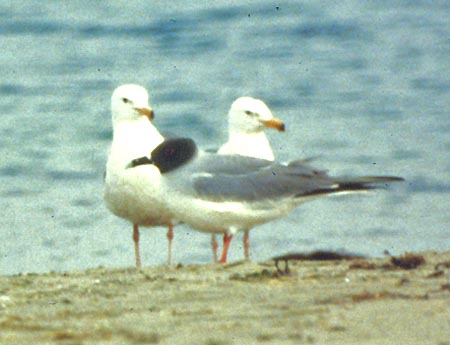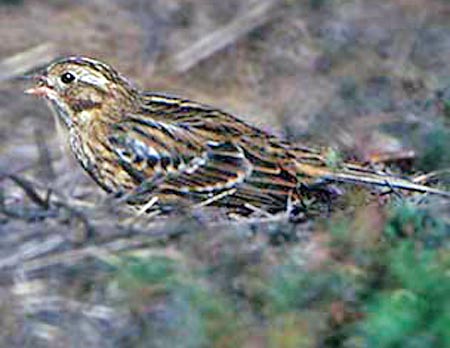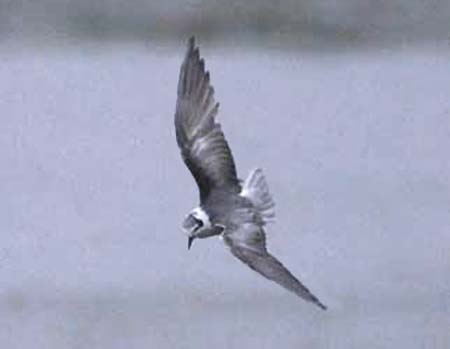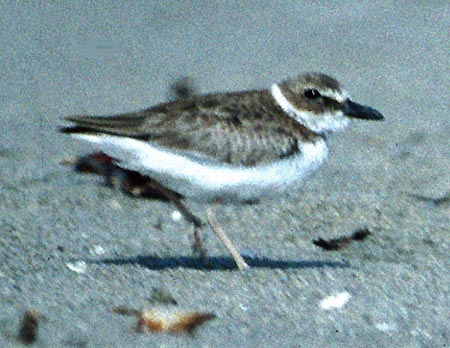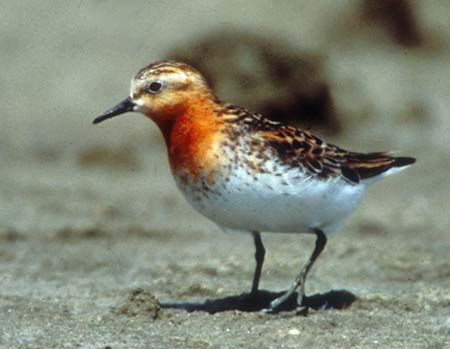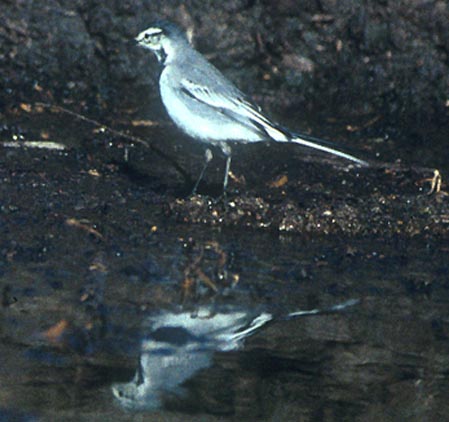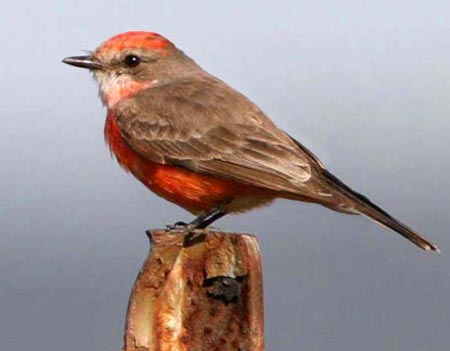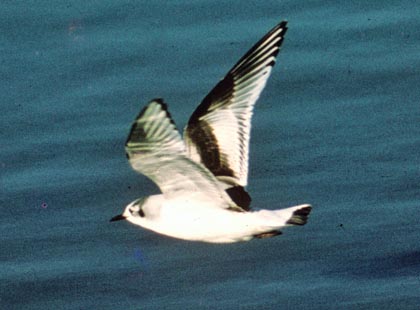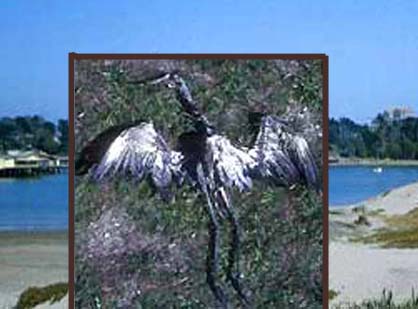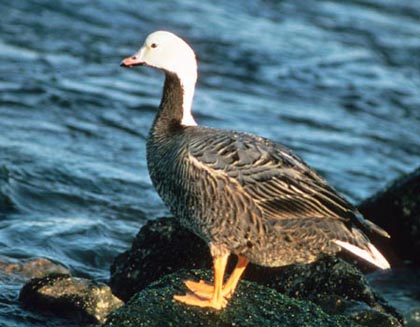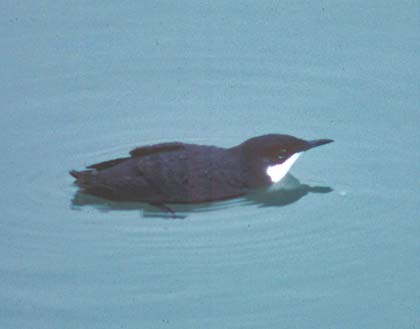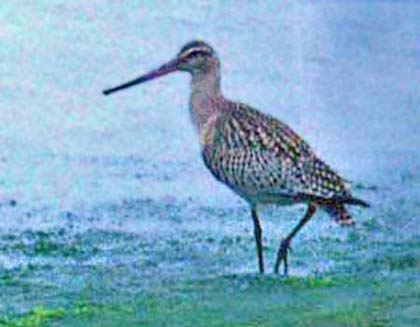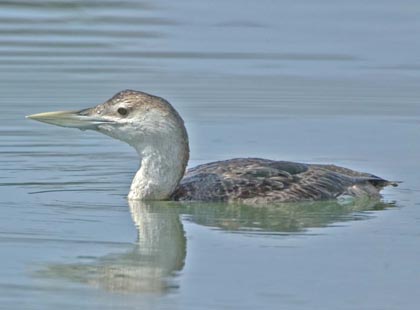'TOP TEN' BIRDS AT ELKHORN SLOUGH / MOSS LANDING |
| My
choices for the ten best birds ever seen around Elkhorn Slough, Moss
Landing, and vicinity are set out below. Remarkably, each of the
rarities was photographed, and those photos appear below (sometimes
imposed over a background because of the dimensions of the photo). |
#1 Swallow-tailed Gull at Moss Landing Harbor 8 June 1985
photo © W. Ed Harper
The
gull roost at Moss Landing Harbor is a good spot to check, even when
just driving by, and that is what Ed Harper did on 8 June 1985. Ed had
left Sacramento predawn to 'chase' the Swallow-tailed Gull that had
been at Hopkins Marine Station, Pacific Grove, on 6-7 June, but he, and
many others waiting at Hopkins, were disappointed. Ed checked Moss
Landing enroute home, and there was the gull! He telephoned me at home
(I had just arrived after leaving Hopkins). I rushed back, told those
left at Hopkins the news, and we all sped north. A group of us arrived
at Moss Landing in time to see the adult at the gull roost, but before
long it took flight, headed out to sea, and was never seen again.
Swallow-tailed Gull is among the best birds ever found in California.
It was controversial on origin issues for years — until another was
seen at sea — but its occurrence followed the 1982-83 El Niño,
the strongest climatic anomaly in the southeastern Pacific during the
20th century. For a time the entire world population was dispersed away
from the Galapagos. Such birds may wander for years until finding a new
landfall, as did this one in June 1985.
|
|
|
#2 Smith's Longspur at Moonglow Dairy 13-18 Sep 1990
photo 14 Sep 1990 © Don Roberson
It
was Doug George who walked the dike around "pond #1" at Moonglow Dairy
on 13 Sep, and found a skulking longspur feeding on the levee. He was
uncertain of its specific i.d. He telephoned me; I telephoned Joe
Morlan in San Francisco; and we converged to view the mystery bird,
finally becoming convinced it was California's first Smith's Longspur.
We spread the word via the birding grapevine, and the imm male kept put
over the next 5 days for those 'chasing' it from all corners of the
State.
This still remains among the best
"Mega" birds from Monterey County. There are now a half-dozen or so
California records, but only three from northern California, and this
is still the only one found in MTY.
|
#3 White-winged Tern at Moonglow Dairy 4 Sep-16 Oct 1999
photo 7 Sep 1999 © Ronald L. Branson
Speaking
of a "Mega" bird (see Smith's Longspur), the rare appearance of any
Siberian species in California is a "mega-event." So it was in fall
1999. A couple local birders had reported a "Black Tern" on Moonglow's
"pond #3" in late August, but it wasn't until Ed Kwater, a visitor from
Florida, stopped there on 4 Sep that the small tern was correctly
identified as a White-winged Tern — only the second ever for
California! Word got out thereafter and hundreds of birders from across
the West made the pilgrimage here over the next month. The second-fall
individual remained to mid-October, the latest ever for North America.
The combination of Smith's Longspur (1st CA record), White-winged Tern
and Little Stint (both 2d State records), and White Wagtail (6th M. a. ocularis
for CA) made the three ponds at Moonglow perhaps the most famous
vagrant ponds in the State, vying with Crespi Pond for that
distinction. |
|
|
#4 Wilson's Plover at Moss Landing SB 15 Sep 1992-1 Jan 1993
photo 15 Sep 1992 © Don Roberson
The
western population of Snowy Plover is a State and Federal endangered
species, and a recovery plan was developed that included banding,
monitoring, and nest protection. It was during a Snowy Plover
monitoring project in Sep 1992 that Bernadette Ramer, Doug George, and
others found this big-billed plover — the only northern California
record of Wilson's Plover! Once settled it with a flock of Snowies, the
first-fall Wilson's seemed right at home on the sandy shore of Moss
Landing SB, and remained until at least 1 Jan 1993. |
#5 Little Stint at Moonglow Dairy 10-21 Sep 1985
photo 19 Sep 1985 © Don Roberson
On
10 Sep 1985, John Mariani reported a juvenal Little Stint at pond #1 at
Moonglow. He took photos, but those would not be processed for weeks.
Birders had read the recently published paper by Jønsson &
Grant (1984) "I.d. of stints and peeps," British Birds 77:
293-315, and were prepared to search for vagrants, using new
characters. On 14 Sep, I located a juvenal Little Stint on pond #1, and
spread the word. Comparison of photos much later proved it to be the
same Little Stint found by Mariani. Crowds gathered over the next few
days to view it . Pond #1 was half full with just a few mud bars
showing The Little Stint was identified by a combination of its
unwebbed toes, short and fine-tipped bill, contrasty mantle pattern of
black-centered scaps and coverts, long primary projection, prominent
white 'braces' on the back, and a prominent split supercilium. Another
juvenal Little Stint was on this same pond, found by Todd Easterla, on
14 Sep 2008. |
|
|
#6 Lesser Sand-Plover at Moss Landing: 3 records
13-19 Sep 1980, 14-16 Aug 1989,
16-20 Sep 1992
photo 17 Sep 1992 © John Sorensen
As
discussed above, on 15 Sep 1992 Snowy Plover researchers discovered a
Wilson's Plover on Moss Landing SB. Clay Kempf, Kim Kuska, and others
'chased' that super-vagrant the next day. They saw the Wilson's . . .
and discovered a newly arrived juv "Mongolian Plover," now known as
Lesser Sand-Plover (photo left)! This is another example of the
"Patagonian Rest Stop Effect" in birding [skilled birders flocking to a
good spot because of a rarity are likely to find another rarity]. This
was not the first Lesser Sand-Plover in MTY, but was the first to be
photographed. Donna Dittmann & Carol Deuel found the first
California record on 13 Sep 1980 at the Moss Landing salt ponds (now
Moss Landing W.A.); a juv that stayed to 19 Sep 1980. Doug George found
the second MTY record (3rd for CA) there on 14-16 Aug 1989. Moss
Landing thus hosted 3 of the first 5 Lesser Sand-Plovers to be
discovered in California. |
#7 Rufous-necked Stint at Moss Landing W.A. 13-14 July 2001
photo 14 July 2001 © John Sorensen
Snowy
Plover work also led to the finding on this stunning vagrant. Doug
George was monitoring nests in the Moss Landing Wildlife Area on 13
July 2001 when he found this gorgeous breeding-plumage adult in fall
migration. Because of the breeding plovers, the Wildlife Area is
off-limits to the public, so it took a day to arrange a 'one-time-only'
supervised visit for hardcore local birders the next day. There was
many an anxious moment until the bird was refound, but then some
lengthy scope views were obtained, and those with powerful lens
obtained great photos from a distance. There are now about a dozen
records for California, and all but one of them have been adults in
spring (May-June) or fall (late June-July) migration. This species
breeds primarily in Siberia. |
|
|
#8 White Wagtail at Moonglow Dairy 23 Dec 1988–21 Jan 1989,
4–11 Dec 1989, and 7 Nov 1990–21 Jan 1991
photo 22 Dec 1990 © Don Roberson
Another
Siberian species is White Wagtail. For a time (1982-2005), the AOU
checklist split northeast Asian populations into two species: White M. alba ocularis
and Black-backed M. lugens wagtails. Some ocularis nest in western
Alaska; lugens is a bird of Kamchatka to Japan. A first-year ocularis
was found by Doug George at Moonglow Dairy, Moss Landing 23 Dec 1988-21
Jan 1989. A White Wagtail that frequented the Pajaro R. mouth on both
sides of the MTY/SCZ line 4-11 Dec 1989, and returned for another
winter at Pajaro R. mouth 7 Nov-1 Dec 1990, then moving back to
Moonglow Dairy 21 Dec 1990-21 Jan 1991 was, in my judgment, the same
bird returning for 3 successive winters. This explanation is consistent
with records of other returning wagtails in California. When at
Moonglow it foraged along the edges of half-empty pond #1 (photo left)
or the drying piles of cow manure that stretched out from the dairy.
Birders chasing this "mega" were thus treated to a variety of visual
and olfactory sensations. Together with an earlier adult male lugens along the Pajaro River in Aug-Sep 1979, returning Jul-Sep 1990, and a fall vagrant ocularis at Big Sur R. mouth in Sep 1998, there are now three records of White Wagtail for MTY.
|
#9 Roseate Spoonbill at Moss Landing 1 Jan–13 Feb 1978
photo Jan 1978 © Bernadette Ramer
In
1973 and again in 1977 there were amazing influxes of Roseate Spoonbill
into southern California, primarily around the Salton Sea. There were
at least 79 between June–Oct 1973, and ~40 in fall 1977. Still, no one
imaged that this tropical wader would reach northern California. But on
the annual Moss Landing CBC following the 1997 flight — the 1st of the
year every year, thus 1 Jan 1978 — Phil Gordon found a bright pink bird
with Great Egrets in an artichoke field near Castroville. For six weeks
thereafter this Roseate Spoonbill was seen around the Moss Landing
area, including the old Salinas River channel where it was photographed
with the pilings of the old one-way Sandholt Bridge in the background.
There have been a few small influxes of spoonbills to the Salton Sea in
recent years, but this remains the only one to reach northern
California. |
|
|
#10 two Vermilion Flycatchers at Moonglow Dairy 10 Oct 2004–28 Feb 2005,
both returning
4-8 Oct 2005, with one present to 12 Feb 2006
photo 30 Jan 2005 © Don Roberson
One
of the fun stories of autumn 2004 was that of two male Vermilion
Flycatchers at Moonglow Dairy. Michael Getty found the first bird, a
young male, on 10 Oct 2004 but by 29 Oct a second young male was
reported. Rarely were they seen together, and both were not
photographed on the same day until 30 Jan 2005, but both lingered well
into winter. The most oft-seen male was in the little fenced wetlands
to the left of the main road into the dairy, just past the power lines.
The second young male was more often to the west, around the edge of
the power plant. There were small differences in the amount of red on
the underparts, the extent of red on the head, and the pattern and wear
on various wing coverts. Both were present in 2006; one lingered to 5
March. Incredible, both returned the following winter, beginning 4 Oct
2005 (Alex Darocy) to the west the 2nd bird at its 'usual' spot in the
small wetland patch on 8 Oct. One disappeared at 22 Oct but the other
wintered to at least 12 Feb 2006. These constitute the 6th & 7th
MTY records of this attractive flycatcher — and by far the most fun, as
everyone who wished to got to see them during their prolonged visit. |
|
Other excellent birds, but unphotographed, include:
Lesser Black-backed Gull on Elkhorn Slough 11 Jan 2003 (Todd Easterla) — 2d MTY record (21st in California)
|
Bonus picks: |
Little Gull at Zmudowski SB pond 19 Jan–1 Mar 1975
photo Jan 1975 © Gary Zamzow
This
Old World gull, the world's smallest gull, is rare anywhere in North
America (although there has been sporadic breeding in Hudson Bay area).
There were a couple in southern California in the 1960s, but the
State's first truly 'chaseable' one was this first-winter bird at the
pond by Zmudowski SP from 19 Jan-1 Mar 1975. It was found by Brian
McCaffery and his father, and 'chased' by many as a lifer and State
bird. [It was one of my first 'chases' in California; I was living in
Berkeley at the time.] There have been 3 others since then in MTY, but
none have had the impact of this vagrant. |
|
|
Reddish Egret at Elkhorn Slough 2-8 Oct 1990
photo 28 Jan 1990 © Don Roberson
This
southern egret is rare in California, but there are now about 100 State
records, the vast majority around San Diego. Only two have reached
northern California, and both of those were around Moss Landing. Both
were hatch-year birds. The first was present from sometime in August
through 8 Oct 1967, but was not identified until rather late in its
stay (it was initially called a "Little Blue Heron"). The second
visited the salt ponds (Moss Landing W.A., where discovered by Carolyn
Rodgers & Doug George) and Elkhorn Slough (could be scoped from
Moonglow Dairy) from 28 Dec 1989–25 Jan 1990. In January it was often
along Jetty Road, but was found dead on 28 Jan 1990 near the base of
the jetty (by Alan & Sheila Baldridge). The photo (left) is of the
carcass, inset against the harbor. It is now a specimen at Calif. Acad.
Sciences. |
Emperor Goose at Moss Landing: ~1950; 1 Jan–20 Mar 1978,
and 29 Dec 2002–7 Jan 2003
photo Jan 1978 © Ronald L. Branson
This
lovely Alaskan goose rarely makes it as far south as California, but
there are now 6 records for MTY, and three of these were at Moss
Landing. The first was shot by a hunter about 1950, and is now on
display at Pacific Grove Mus. Nat. Hist. The next was an adult that
visited Moss Landing harbor 1 Jan–20 March 1978 (photo right), which
could be successfully 'chased' by interested observers. The third was a
young bird on Elkhorn Slough 29 Dec 2002–7 Jan 2003. It, too, was
'chaseable' for a short while — and could be scoped from Moonglow
Dairy, although it favored a resting spot at a point on the curve of
Elkhorn Slough — until it, too, was apparently shot by a hunter in
early January. |
|
|
Craveri's Murrelet at Moss Landing Harbor
14 Aug 1972 &
7 Oct 1978
photo © Don Roberson
Craveri's
Murrelet breeds on islets in the Gulf of California and off the tip of
Baja California. It disperses northward in late summer/fall, and can be
common at times offshore southern California. In some warm water years,
fair numbers can reach Monterey Bay. Still, these birds are seen on
boat trips, usually rather far offshore in fingers of warmer water, and
quite exceptional near shore. A few fly-bys have been seen from Pt.
Pinos & Cypress Pt., but only twice (so far) have birders had the
luxury of studying one from solid ground in the harbor. On 14 Aug 1972,
Ted Chandik, Bob & Carol Yutzy, and others, had one just off Jetty
Road. During a 'Big Day' effort on 7 Oct 1978, L.C. Binford, the
Parmeters, and I had this one (left) right next to Moss Landing Road at
the edge of the marina. As it was a 'Big Day,' though, we hardly had
any time to enjoy the moment before rushing off . . . |
Bar-tailed Godwit at Moonglow Dairy 5-8 Sep 1994
photo © Don Roberson
Rita
Carratello & I were walking along the Moonglow dike on 5 Sep 1994,
and had just reached the famed "Smith's Longspur" spot (see bird #2,
above), when I spotted this juvenal-plumaged Bar-tailed Godwit with a
small flock of Marbled Godwit. It proved to be 'chaseable,' but the
very next day (6 Sep 1994) Bill Hill & Dave Haupt independently
found a Little Curlew at Carmel R. mouth, and the stampede was on! This
cool godwit, of the Siberian race baueri, became a small footnote. At the time it was just the 2d record for MTY, and the 18th for California. |
|
|
multiple Yellow-billed Loons at Moss Landing / Elkhorn Slough
photo18 Apr 2004 © Bill Hill
Yellow-billed
Loon is a northern breeder that is very rare this far south. Yet, in
California, 8 of the State's first 10 records were in MTY! Six of those
were around the Monterey Peninsula, but 2 were here in Moss Landing (23
Jan-6 Mar 1971, now a specimen at MVZ, Berkeley, and 26 Jan 1971).
Since then over 20 more Yellow-billed Loons have visited MTY, and
several more have been at Moss Landing, including10 Jan-13 Feb 1991,
and this first-winter bird on Elkhorn Slough, first spotted by Shirley
Murphy, between 15 Apr-17 May 2004. It ranged from Kirby Park — where
it could be seen at close range (photo left) — to Moonglow Dairy (where
a scope was needed).
|
|
|
